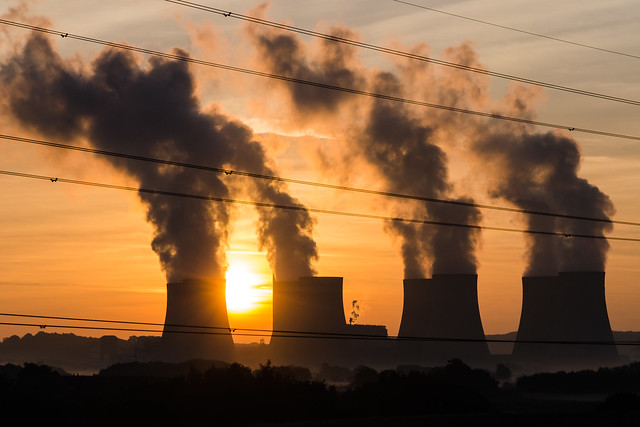Difference Between Biofuel and Fossil Fuel
What is Biofuel?
Biofuel is liquid fuel that has been made from biomass, a collective term referring to crops, plant residues, organic waste, and anything that originated from a living organism. The most common forms of biofuel are ethanol and biodiesel.
Types of biofuel
Biofuel can come in different forms depending on how it is made and the material from which it is produced.

Ethanol
Ethanol is typically made from sugars found in grains such as corn, barley and sorghum. Ethanol is generally used as a replacement for petroleum-derived gasoline in automobiles and other technology systems that have traditionally used petroleum gasoline. Some ethanol is used in almost all gas in the United States. There are currently two forms of ethanol-petroleum gasoline mixtures used in the U.S., a mixture with 10% ethanol (E10) and a mixture with about 50-80% ethanol (E85). Most gasoline-powered vehicles can use E10 gasoline. Gasoline-powered vehicles that are model 2007 or newer can use gasoline that is E15 or 15% ethanol. Currently only flexible-fuel vehicles can use E85 gasoline.
Most ethanol is currently made from plant sugars found in grains, but research is currently being done on whether ethanol can be made from cellulosic parts of plants. This ethanol is referred to as cellulosic ethanol.
Biodiesel
Biodiesel is made from vegetable oils and animal fats. It can also be made from cooking grease. It is used to replace petroleum-based diesel in compression-ignition engines. The use of biodiesel does not require that the engine be changed or modified, provided that it is a diesel engine.
Pros and cons of biofuels
Biofuels have been promoted as a renewable, green alternative to fossil fuels. One the other hand, there are some challenges to the usefulness and sustainability of biofuels as a replacement for petroleum-based fuels.
Pros
Unlike petroleum based-fuels, biofuels are generally nontoxic. Furthermore, they are often promoted as a carbon-neutral fuel source. The reasoning is that since the plants used to make the biofuels are always regrown, the new plants will re-absorb the carbon dioxide released into the atmosphere by the burning of biofuels. Another reason that biofuels are promoted is that they potentially allow for less dependence on imported petroleum and can allow for more local sustainability for a country if it has abundant land in which to grow fuel crops.
Cons
Although biofuels have been suggested to provide a substitute for fossil fuels, recent research suggests that the amount of energy produced by biofuels is not enough to replace fossil fuels without converting most of the planet’s non-urban land surface to farmland to produce the crops needed for biofuel production.
In one study, for example, it was found that replacing 5% of diesel consumption with biodiesel would require converting 60% of current soy farms to biofuel production. Research at Cornell University also suggests that more energy is needed to produce biofuels than the energy provided by the end-product. This makes it questionable whether biofuels can be applied on the same scale as fossil fuels. Additionally, the use of biofuels can create competition between land for food crops and fuel crops. This could make it a challenge to provide enough fuel for a country and feed everyone in that country at the same time.
Another problem with biofuels is that not all biofuels are carbon neutral. Recent research shows that biofuels made from grain crops produce about as much carbon emissions as fossil fuels. Re-growing the crops used to make the biofuels also does not necessarily reduce the carbon emissions. This is because the new fuel crops do not absorb carbon dioxide fast enough to make up for the emissions that are the result of burning biofuels. Biofuels produced from crop residues or waste, on the other hand, tend to reduce carbon emissions.
These problems do not mean that biofuels cannot be used, but they do suggest that the scale at which they can be used is limited just like fossil fuels.

Fossil Fuel
Fossil fuels are fuels that are derived from the remains of dead organisms that lived millions of years ago. Fossil fuels include oil, coal, and natural gas, as well as tar and bitumen. Fossil fuels are nonrenewable because the process that forms them requires millions of years, making them impossible to replenish over the timescale typical of human civilizations.
Types of fossil fuels
Fossil fuels are all created from formerly living material, such as plants and algae, being naturally subjected to heat and pressure. Fossil fuels can occur in liquid, solid, and gas forms.
Oil
Oil is a liquid substance composed of hydrocarbons that once composed living organisms. Typically, oil will be found within a permeable rock layer, such as sandstone or limestone, overlain by an impermeable rock layer, usually evaporites, that will keep the oil from escaping. Beneath the permeable rock layer will be a layer of shale. The oil originates from the shale layer.
The United States is currently the world’s largest consumer of oil. The largest exporters of oil to the United States include Saudi Arabia, Canada, Mexico, and Nigeria. Oil is typically the source of gasoline and other liquid fossil fuels used to power land vehicles and aircraft. It is a very important fuel source for transportation.
Although oil has provided a wealth of energy, it also has significant drawbacks. Extraction methods are hazardous to the natural environment, as recent oil spills have demonstrated. Also, the burning of oil is known to release particles into the air that adversely affect the lungs of humans and animals. Furthermore, the burning of oil also releases significant amounts of carbon dioxide into the atmosphere, which is causing the global average temperature to rise, changing the global climate in ways that are not beneficial to human civilization or many plant and animal species.
Coal
Coal consists of a solid mass of hydrocarbons produced from heat and pressure. Coal forms primarily from dead plants. Coal also has several different grades.
The precursor to coal is peat, a soft organic material made of decaying plant matter. If the peat is subjected to heat and pressure, it will transform into coal. Lignite or brown coal is the lowest grade of coal. It has relatively low carbon concentration and is subject to relatively low heat and pressure during formation.
Subbituminous and bituminous coal are forms of coal that are intermediate between anthracite, the highest form of coal, and lignite. Subbituminous coal is dull while bituminous coal is shiny and smooth. Bituminous coal is also the most common type of coal used in power generation. Anthracite contains the highest concentration of carbon and has been subject to the greatest heat and pressure. It is hard and brittle compared to other forms of coal.
Coal played a very important role in the industrial revolution and is used in many countries around the world as a cheap power source. Coal is principally used for the generation of electricity. Currently the largest producer of coal is China, producing 48% of the world’s coal supply. The United States produces about 11% of the world’s coal, particularly in states like Pennsylvania, Wyoming, Illinois, and Kentucky.
Although coal can provide significant power for electricity, it also is one of the most environmentally harmful fossil fuels currently in use. The extraction of coal is known to destroy large swaths of vegetation and contaminate rivers with toxic mine wastes. The burning of coal also produces mercury, sulfur dioxide, and nitrogen oxides that can cause acid rain. Furthermore, coal contributes significantly to the carbon dioxide emissions produced by human civilization.
Natural gas
Natural gas is mostly used for heating and electricity and is considered to be a cleaner, relatively low-carbon alternative to other fossil fuels. The United States is a significant user and producer of natural gas.
The burning of natural gas does produce much less carbon dioxide than the burning of oil or coal and releases far fewer pollutants into the atmosphere. However, it is still the cause of 29% of carbon emissions in the United States.
Similarities between Biofuel and Fossil Fuel
Biofuels and fossil fuels are both made from once living matter. They are also both used to produce heat and electricity as well as to power vehicles and generators around the world. They also produce significant carbon emissions and the sustainability of their continued use is questionable in light of their effects on the environment.
Differences between Biofuel and Fossil Fuel
Although there are many similarities between fossil fuels and biofuels, there are also significant differences which include the following.
- Biofuels are renewable, whereas fossil fuels are nonrenewable.
- Biofuels are mostly grown from modern grains or the organic residues of modern plants, whereas the organisms that fossil fuels are made from have been dead for millions of years.
- Toxic gases and particles that cause lung irritation or damage are produced as byproducts of the burning of fossil fuels, whereas biofuels are generally nontoxic by themselves.
- The use of fossil fuels is presently controversial and there are currently significant attempts being made by many countries to move away from fossil fuels. Biofuels on the other hand, are considered environmentally friendly and are becoming more popular.
Biofuel vs. Fossil Fuel

Summary
Biofuels are produced from plants and other organic matter that have been converted into liquid fuel. Types of biofuel include ethanol and biodiesel. Ethanol is generally made from grains, except for cellulosic ethanol. Biodiesel is made from vegetable oil, animal fat, and used cooking grease. Ethanol is made to replace gasoline, while biodiesel is used to replace diesel. Biofuels are generally nontoxic and can make a country less reliant on foreign imports of fossil fuels. On the other hand, biofuels do not provide enough energy to completely replace fossils fuels. The use of biofuels also creates competition between crops grown for food and crops grown for fuel. Furthermore, it produces about the same amount of carbon emissions in many cases as fossil fuels. Fossil fuels are made from organisms that died millions of years ago and whose remains were subjected to heat and pressure. Fossil fuels are considered nonrenewable because they take millions of years to form. Fossil fuels and biofuels are similar in that they are both formed from once living matter and both emit carbon dioxide when burned for energy. They differ in that biofuels are renewable, generally nontoxic, and a growing industry, whereas fossil fuels are non-renewable, often have significantly toxic biproducts, and are a waning industry.
- Difference Between Environmental Performance Index and Development - November 24, 2023
- Difference Between Environmental Intervention and Development - November 8, 2023
- Difference Between Eco Efficiency and Eco Effectiveness - September 18, 2023
Search DifferenceBetween.net :
 Email This Post
: If you like this article or our site. Please spread the word. Share it with your friends/family.
Email This Post
: If you like this article or our site. Please spread the word. Share it with your friends/family.
3 Comments
Leave a Response
References :
[0]image credit: https://www.flickr.com/photos/jurvetson/383416585
[1]Image credit: https://www.flickr.com/photos/gellscom/9460755014
[2]“Biofuels Basics.” N.D. Office of Energy Efficiency and Renewable Energy. Available at: https://www.energy.gov/eere/bioenergy/biofuels-basics
[3]“Biofuels: Ethanol and Biodiesel Explained.” N.D. U.S. Energy Information Administration. Available at: https://www.eia.gov/energyexplained/index.php?page=biofuel_home
[4]Stecker, Tiffany. 2014. Biofuels Might Hold Back Progress Combating Climate Change. Scientific American. Available at: https://www.scientificamerican.com/article/biofuels-might-hold-back-progress-combating-climate-change/
[5]Edelstein, Stephen. 2015. Biofuels: Don’t Assume They’re All Carbon Neutral, New Study Warns. Green Car Reports. Available at: https://www.greencarreports.com/news/1098269_biofuels-dont-assume-theyre-all-carbon-neutral-new-study-warns


Wow! Your article had been of a great help to me. Is very good u recommend it to many persons. Thks
Wow! Your article had been of a great help to me. Is very good I recommend it to many persons. Thks
Bruh u just made 2 accounts and copy and pasted comments kys.